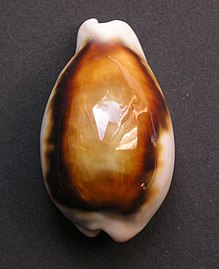
Cowrie or cowry is the common name for a group of small to large sea snails in the family Cypraeidae.

Navanax inermis, common name the California aglaja, is a large species of predatory sea slug, a marine opisthobranch gastropod mollusk in the family Aglajidae. Navanax is not a nudibranch, even though it somewhat resembles one; it belongs to a more ancient lineage of opisthobranchs called the cephalaspideans or head shield slugs and snails.

Doryteuthis opalescens, the opalescent inshore squid or market squid, is a small species of squid in the family Loliginidae. It is a myopsid squid, a near shore group with corneas over their eyes. The species is found in the eastern Pacific Ocean from Baja California, Mexico to Alaska, United States, and as an inshore squid can be found within a range of 200 miles (320 km) off the coast.

Tegula funebralis, the black turban snail or black tegula, is a species of medium-sized marine sea snail in the family Tegulidae. This eastern Pacific Ocean species was previously known as Chlorostoma funebralis.
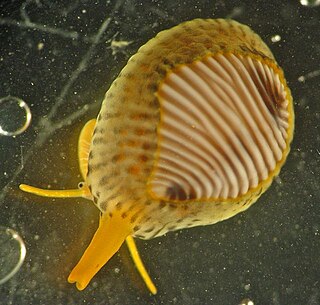
Trivia monacha, also known as the European cowrie or spotted cowrie, is a species of small sea snail, a marine gastropod mollusc in the family Triviidae, the trivias.
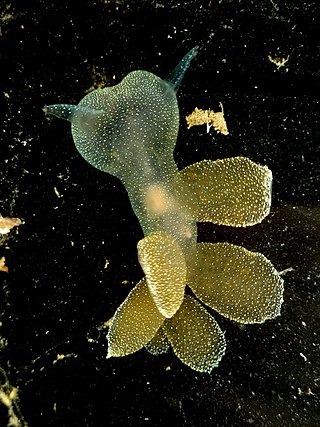
Melibe leonina, commonly referred to as the hooded nudibranch, lion nudibranch, or lion's mane nudibranch, is a species of predatory nudibranch in the family Tethydidae.
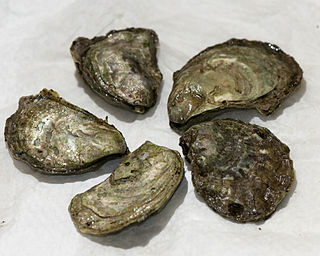
Ostrea lurida, common name the Olympia oyster, after Olympia, Washington in the Puget Sound area, is a species of small, edible oyster, a marine bivalve mollusk in the family Ostreidae. This species occurs on the northern Pacific coast of North America. Over the years the role of this edible species of oyster has been partly displaced by the cultivation of non-native edible oyster species.
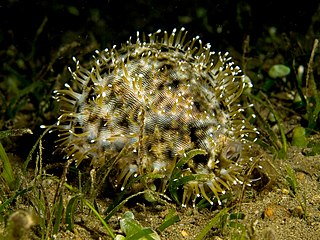
Cypraea tigris, commonly known as the tiger cowrie, is a species of cowry, a large sea snail, a marine gastropod mollusk in the family Cypraeidae, the cowries.
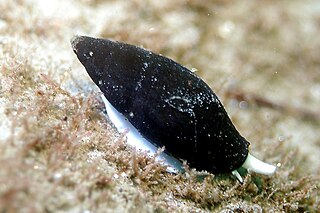
Atrimitra idae, common name Ida's miter, is a species of medium-sized sea snail, a marine gastropod mollusk in the family Mitridae, the miters.

Cadlina flavomaculata, common name the yellow-spot cadlina, is a species of colourful sea slug, a dorid nudibranch, a shell-less marine gastropod mollusk in the family Cadlinidae.

Talostolida teres, common name the tapering cowry, is a species of sea snail, a cowry, a marine gastropod mollusc in the family Cypraeidae, the cowries.

Phenacovolva rosea, also known as the rosy spindle cowry, is a species of sea snail, a marine gastropod mollusc in the family Ovulidae, the ovulids, cowry allies or false cowries. It lives and feeds on fan, whip and bush-type gorgonians.

Monoplex pilearis, common name the hairy triton, is a species of medium-sized predatory sea snail, a marine gastropod mollusk in the family Cymatiidae.
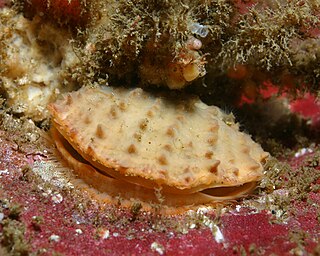
Crassadoma is a genus of rock scallops, marine bivalve molluscs in the family Pectinidae. It is monotypic, the only species being Crassadoma gigantea, the rock scallop, giant rock scallop or purple-hinge rock scallop. Although the small juveniles are free-swimming, they soon become sessile, and are cemented to the substrate. These scallops occur in the eastern Pacific Ocean.
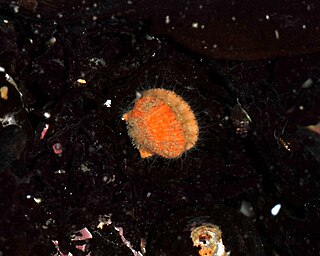
Leptopecten latiauratus, common name the kelp scallop, is a small saltwater clam, a bivalve mollusk in the family Pectinidae, the scallops. It lives in water up to 850 feet deep. Like other scallops it has many small primitive eyes around the rim of its mantle and escapes predators by jet propulsion.

Zoila thersites, the humpbacked cowry or black cowry, is a species of sea snail, a cowry, a marine gastropod mollusk in the family Cypraeidae, the cowries.

Paraconcavus pacificus, the red-striped acorn barnacle, is a species of balanid barnacle known from subtidal sandy habitats of the outer northeastern Pacific coast, from Baja California north to Monterey Bay. It grows to 35 mm in diameter, with pink longitudinal stripes over white plates, and can be distinguished from other large, pink-striped barnacles in its range by the longitudinal striations across the growth rings of its plates. While it will attach to many different kinds of hard substrate, it shows a preference for attaching to the shells of other organisms, particularly sand dollars.
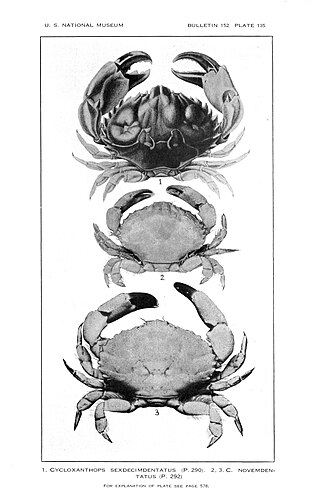
Cycloxanthops novemdentatus, commonly referred to as the ninetooth pebble crab, is a small crab in the family Xanthidae.

Lamellaria perspicua, commonly known as the transparent lamellaria, is a species of small, slug-like sea snail, a marine gastropod mollusc in the family Velutinidae. It is native to the northeastern Atlantic Ocean and the Mediterranean Sea, where it feeds on colonial ascidians.

Smaragdinella calyculata, also called calyx bubble shell, is a small shelled slug common on rocky shores in the Indo-Pacific including Hawaii.


